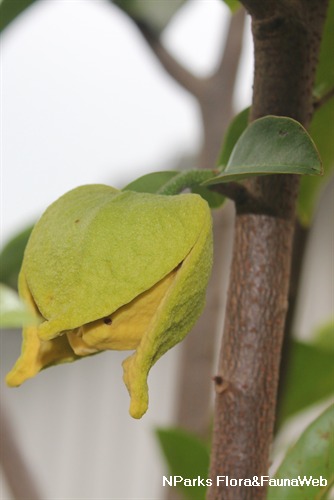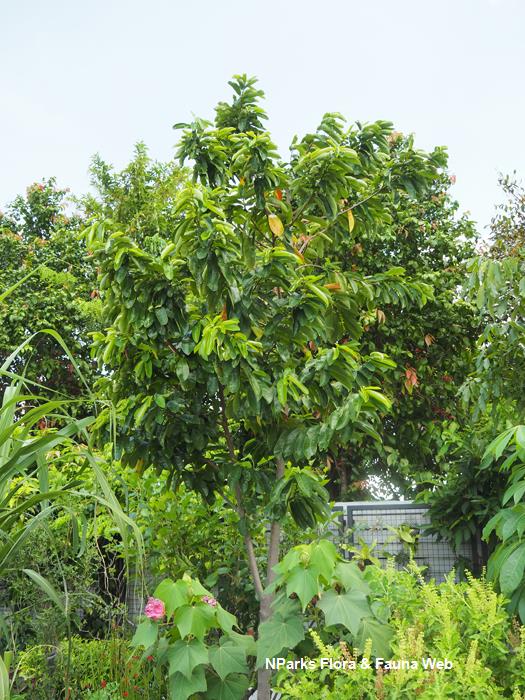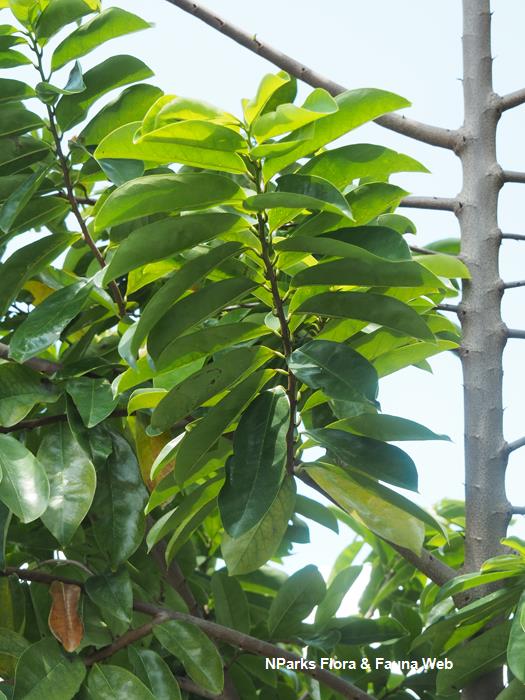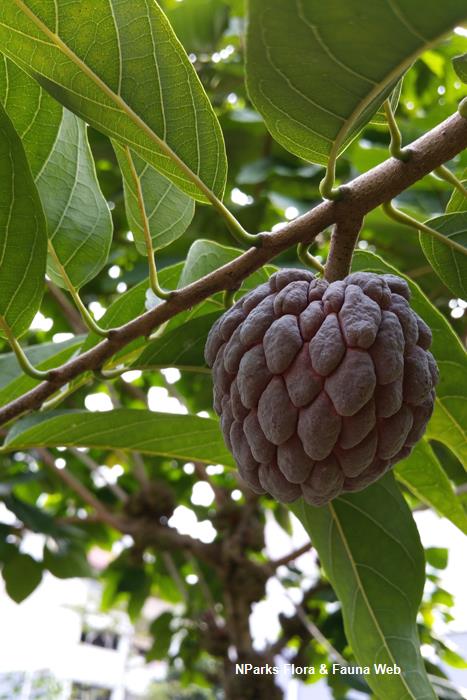
Back
Annona muricata L.
| Family Name: | Annonaceae |
| Common Name: | Soursop, Guanabana, Prickly Custard Apple, Durian Belanda, Graviola, Durian Europa, Durian Makkah, Durian Benggala, 红毛榴莲 |
Annona muricata, also commonly known as Soursop, is a tree which can reach up to 10 m tall. The fruit ripens to green and is covered with distinctive curved prickle. The seed is surrounded with sweet and sour tasting white pulp.
Name
Classifications and Characteristics
| Plant Division | Angiosperms (Flowering Seed Plants) (Dicotyledon) |
|---|---|
| Plant Growth Form | Tree |
| Lifespan (in Singapore) | Perennial |
| Mode of Nutrition | Autotrophic |
| Maximum Height | 10 m |
Biogeography
| Native Distribution | Tropical America |
|---|---|
| Native Habitat | Terrestrial |
| Preferred Climate Zone | Tropical |
| Local Conservation Status | Non-native (Horticultural / Cultivated Only) |
Description and Ethnobotany
| Others - Plant Morphology | Shrub or small tree, 3.0 – 10.0 m in height. Annona muricata is a low-branching and slender yet slender as its limbs are upturned. Normally evergreen, the leaves have an offensive smell, alternate, smooth, glossy and is dark green on the surface, lighter beneath. Leaves are oblong, elliptic or narrowobovate, pointed at both ends and is 6.25 – 20 cm long and 2.5 – 6.25 cm wide. Flowers may appear anywhere on the trunk, branches or twigs and is borne singly. Flower, short stalk, 4 – 5 cm long, plump, in a triangle-conical shape, have 6 petals, with 3 yellow green slightly spreading fleshy petals as the outer layer and 3 pale yellow close-set petals as the inner petals. Ripe fruit is dark green, covered with soft, short spine and is pseudocarp, broadly ovoid or ellipsoid.Able to tolerate most soil condition but not waterlogged condition. Propagated by seeds, germinate within 20 – 30 days. Soil should be kept moist and seedlings, shaded. To avoid dehydration of the shallow root system, mulching is recommended during dry and hot weather. The tree will shed off its old leaves, before new ones appear, in too dry a situation. Fruits will appear after 3 – 5 years.Best harvested when the fruit is fully-grown and firm as if it is allowed to soften on the tree, it will fall and crushed. The fruits is considered as mature when their spines are far apart and the shiny green colour becomes dull-green or yellowish-green. Fruits are best eaten 5 – 6 days after harvesting and are used as an ingredient in ice-cream, dessert, drinks, etc. |
|---|---|
| Ethnobotanical Uses | Edible Plant Parts : Edible Fruits Food (Fruit or Vegetable) Others: Extraction from leaves is lethal to head lice and bedbugs. When grinded, the seeds are effective pesticides against head lice. The juice of the fruit is said to be able to increase the amount of urine, and treat urethritis and haematuria. Immature fruits are grinded and decocted as a treat for dysentery. |
Landscaping Features
| Landscape Uses | Container Planting |
|---|---|
| Thematic Landscaping | Butterfly Garden, Economic Garden |
| Usage Hazard - Cons | Spines/Thorns - Fruit, Low Crown / Clearance |
| Usage Hazard - Cons Remarks | Although the fruits have spines, it is rather short, 6 mm long, and is soft. |
Fauna, Pollination and Dispersal
| Fauna Pollination Dispersal Associated Fauna | Butterfly Host Plant |
|---|---|
| Pollination Method(s) | Biotic (Fauna) (Insects (Bee), Insects (Ant, Beetle, Fly, Thrip, Wasp)) |
Plant Care and Propagation
| Light Preference | Full Sun |
|---|---|
| Water Preference | Moderate Water |
| Plant Growth Rate | Moderate |
| Diseases | In humid condition, anthracnose (Colletotrichum gloeosporioides) is the principal diease. The infection will cause the flowers and fruits to rot and shrivel. Furthermore, the disease will affect maturing fruits, leaves and stems as well. Another pest that will attack the tree is the brown stem rot (Corticium sp) which will infects and cause decay of branches and might kill the tree. This will usually happened during a dry season. However, a thorough cleaning, which include burning of the infected parts, at the end of the dry season will help to minimize the condition during wet season. Large caterpillars, Meganotron rufescens and Papilio Agamemnon, are usually found eating the leaves. |
| Propagation Method | Seed, Grafting |
Foliar
| Mature Foliage Colour(s) | Green |
|---|---|
| Mature Foliage Texture(s) | Smooth, Glossy / Shiny |
| Foliar Type | Simple / Unifoliate |
| Foliar Arrangement Along Stem | Alternate |
| Foliar Shape(s) | Non-Palm Foliage (Ovate, Oblong) |
Non - Foliar and Storage
| Root Type | Underground (Fibrous Root) |
|---|
Floral (Angiosperm)
| Flower Colour(s) | Green, Yellow / Golden |
|---|---|
| Flowering Habit | Polycarpic |
Fruit, Seed and Spore
| Mature Fruit Colour(s) | Green |
|---|
Image Repository
Others
| Master ID | 1966 |
|---|---|
| Species ID | 3258 |
| Flora Disclaimer | The information in this website has been compiled from reliable sources, such as reference works on medicinal plants. It is not a substitute for medical advice or treatment and NParks does not purport to provide any medical advice. Readers should always consult his/her physician before using or consuming a plant for medicinal purposes. |












_lowres.jpg)